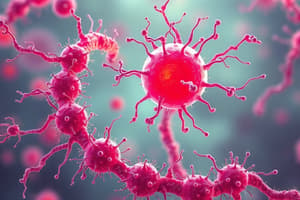Podcast
Questions and Answers
What is the significance of the presence of a lysogenic prophage in the bacterial chromosome of C. diphtheriae?
What is the significance of the presence of a lysogenic prophage in the bacterial chromosome of C. diphtheriae?
It carries the gene for toxin production, influencing the ability of C. diphtheriae to produce the diphtheria toxin.
What is the characteristic arrangement of C. diphtheriae cells?
What is the characteristic arrangement of C. diphtheriae cells?
They are arranged at acute angles or parallel to each other, resembling Chinese letters.
What is the primary mechanism by which the diphtheria toxin causes tissue damage?
What is the primary mechanism by which the diphtheria toxin causes tissue damage?
It inhibits protein synthesis, leading to the death of host cells and tissues.
What is the purpose of using Blood tellurite agar as a selective medium for C. diphtheriae?
What is the purpose of using Blood tellurite agar as a selective medium for C. diphtheriae?
What is the composition of the local pseudomembrane that develops in the upper respiratory tract during diphtheria?
What is the composition of the local pseudomembrane that develops in the upper respiratory tract during diphtheria?
What is the primary mechanism of disease caused by diphtheria bacilli?
What is the primary mechanism of disease caused by diphtheria bacilli?
What is the characteristic appearance of the membrane formed in pharyngeal and tonsillar diphtheria?
What is the characteristic appearance of the membrane formed in pharyngeal and tonsillar diphtheria?
What is the primary laboratory test used to detect the toxigenicity of C. diphtheriae?
What is the primary laboratory test used to detect the toxigenicity of C. diphtheriae?
What is the purpose of administering antitoxin in the treatment of diphtheria?
What is the purpose of administering antitoxin in the treatment of diphtheria?
Why are antibiotics also used in the treatment of diphtheria?
Why are antibiotics also used in the treatment of diphtheria?
Flashcards are hidden until you start studying
Study Notes
Corynebacterium
- Corynebacteria are non-spore-forming Gram-positive bacilli that include many species, some of which are part of the normal flora of the skin and mucous membranes.
- They are collectively known as diphtheroids.
- The most medically important species is Corynebacterium diphtheriae, which causes diphtheria.
Corynebacterium diphtheriae Morphology
- C. diphtheriae are Gram-positive bacilli, club-shaped, and arranged at acute angles or parallel to each other, resembling Chinese letters.
Culture
- C. diphtheriae is a facultative anaerobe that grows on Loeffler's serum (enriched medium) and Blood tellurite agar, a selective medium used for isolation from the pharynx, nose, and skin.
Virulence Factors
- The virulence factor of C. diphtheriae is the exotoxin, which causes death of host cells and tissues by inhibiting protein synthesis.
- Two factors influence the ability of C. diphtheriae to produce the diphtheria toxin:
- The presence of a lysogenic prophage in the bacterial chromosome carrying the gene for toxin production.
- Low extracellular concentration of iron.
Diphtheria
- Diphtheria is a disease caused by C. diphtheriae, which spreads by droplets or direct contact from a case or a carrier.
- The disease involves both local and systemic pathology:
- Local pseudomembrane: develops in the upper respiratory tract (tonsil, pharynx, and/or nose).
- Toxaemia: the diphtheria bacilli produce the toxin that is absorbed and disseminated through blood to target tissues.
Clinical Manifestations
- Incubation period of diphtheria is 2-5 days.
- Pharyngeal and tonsillar diphtheria are the most common forms.
- A greyish-white membrane is formed, which may extend to cover most of the soft palate.
- The membrane is adherent to the underlying tissue and forcible attempts to remove it cause bleeding.
- Extensive membrane formation may result in respiratory obstruction.
- The patient appears quite toxic but fever is usually not high.
- The most frequent complications of diphtheria are myocarditis and neuritis.
- Death may occur from heart failure, airway obstruction, or diaphragmatic paralysis.
Laboratory Diagnosis
- Diagnosis of diphtheria is primarily clinical, and antitoxin therapy should be started before laboratory diagnosis.
- Laboratory diagnosis includes:
- Isolation of C. diphtheriae and detection of its toxigenicity.
- Specimens: throat swabs.
- Direct detection: Gram-stained smears show club-shaped Gram-positive bacilli.
- Culture: specimens are cultured on Loeffler's serum and blood tellurite agar.
- Identification: C. diphtheriae is identified by colony morphology and microscopic examination of stained films.
- Toxigenicity testing: Elek's test, detection of toxin gene by PCR, and detection of toxin from culture by ELISA.
Treatment
- Specific treatment is only effective if administered early before the toxin is bound to the target cell.
- Diphtheria antitoxin:
- Produced in horses.
- Must be given immediately if diphtheria is strongly suspected on clinical grounds.
- Neutralizes circulating (unbound) toxin and prevents progression of the disease.
- Precautions should be taken to avoid hypersensitivity reactions.
- Antibiotics: in addition to diphtheria antitoxin, patients should be given antibiotics in adequate dose to inhibit growth of the organism and reduce toxin production.
- Treatment includes penicillin or erythromycin.
Studying That Suits You
Use AI to generate personalized quizzes and flashcards to suit your learning preferences.




